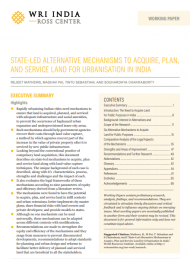Jul 2018
State-led Alternative Mechanisms to Acquire, Plan, and Service Land For Urbanisation in India

- Rapidly urbanizing Indian cities need mechanisms to ensure that land is acquired, planned, and serviced with adequate infrastructure and social amenities, to prevent the occurrence of haphazard urban expansion and under-provisioned inner-city areas.
- Such mechanisms should help government agencies recover their costs through land value capture, a method by which agencies recover part of the increase in the value of private property after it is serviced by new public infrastructure.
- Looking beyond the conventional practice of compulsory land acquisition, this document describes six state-led mechanisms to acquire, plan and service land along with land value capture techniques. The unique background of each case is described, along with its characteristics, process, strengths and challenges and the impact of each.
- It also evaluates the legal frameworks of these mechanisms according to nine parameters of equity and efficiency derived from a literature review.
- The mechanisms were found to have the potential to acquire, plan, and service land in infill contexts and urban extensions; better implement city master plans; share financial risks with land owners and private developers; and provide models to states.
- Although no one mechanism can be used universally, these mechanisms can be adapted across different contexts with modifications.
- Recommendations are made to strengthen the equity and efficiency of the mechanisms and they range from measures to prevent disconnected developments, recommendations to adopt standards for planning and urban design and reforms to facilitate better delivery of planned and serviced land that are beneficial to all the stakeholders.
To view the full paper, click here.
To view the illustrated executive summary, click here.
